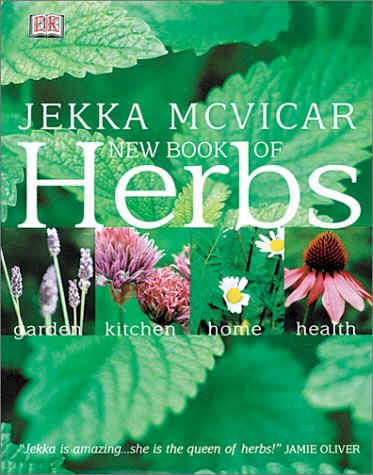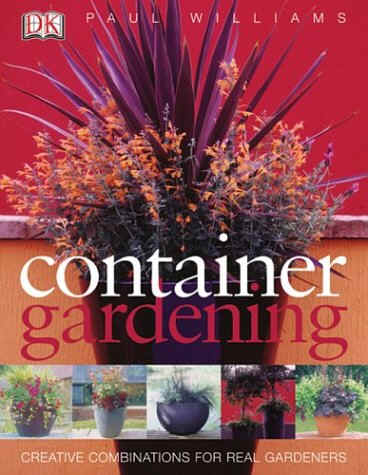|

New Book of Herbs
 Herbs for the Garden, Kitchen, Home and Health, October
23, 2003
Herbs for the Garden, Kitchen, Home and Health, October
23, 2003
"Once you start growing and using herbs, I defy anyone
not to become hooked." ~Jekka McVicar
If you are thinking of growing your own herb garden, I can't
think of a more detailed and interesting book on the subject.
You will find information about how to attract butterflies to
your garden or the reason Queen Victoria requested that jam be
made from Chilean guava berries. Have you ever read about a
"curry leaf" in a recipe? Well, there is information
in this book on how you can grow your own plant, but probably
only in a greenhouse. A greenhouse seems essential if you are
really serious about gardening.
Jekka McVicar is a popular radio and television personality.
She has helped to revitalize the traditional use of herbs and
shows how herbs can enhance your home, health and garden. Jamie
Oliver calls her the "queen of herbs." Now I
understand why he loves cooking with so many herbs.
My favorite section was the "kitchen" section where
you can learn how to make everything from "borage ice
cubes" to "roasted vegetables with herbs."
Some of the highlights include:
1. An A-Z of the top 100 herbs - Half the book is dedicated
to pictures, cultivation techniques, harvesting tips and uses.
'After trying to grow French lavender from seeds (Hardy Lavender
has more of a chance), I see the plants are best grown from
cuttings taken in the spring. It seems only the "lavandula
stoechas French Lavender" will grow from seeds and probably
only inside with extra warmth, in "coir/bark/perlite,"
and covered with perlite (naturally occurring siliceous rock
with a neutral pH).
I had never even heard of "perlite" before and this
was all very enlightening for me. Coir is the outside layer of
husk surrounding the shell of a coconut and bark would just be
tree bark, but you need a fine grade bark and not fresh green
bark. Finally, I realize why the poor little seeds I planted had
no chance of germinating.
2. Organic Gardening - Many of the herbs can be mixed in with
your vegetable garden. If you grow beans, you might want to grow
"blue borage flowers" alongside as they will attract
bees that will pollinate the beans, producing a larger harvest.
3. Lists of plants that will grow best in sand, clay, chalk,
loam type soils.
4. Designing an Herb Garden
5. Detailed information on growing herbs from seeds, hardwood
cuttings, layering, root cuttings and root division.
6. Using Herbs in Petcare
Ever since discovering a lavender furniture oil, I wondered
how I could make my own. In the "Home" section, there
are recipes for Natural furniture polish, upholstery shampoo and
even herbal window cleaner. You might also want to make up an
herbal first-aid kit. If you have ever steamed your face, you
will appreciated the added benefit of herbs like lemon verbena
or spearmint. There are recipes for mouthwash, shampoo, face
packs, nail strengthener, bath tonics, bath bags and a foot
bath. Having trouble sleeping? You can make a "hop
pillow."
The Top 100 herbs include: Yarrow, Anise hyssop, Lady's
mantle, Onions, Chives, Aloe, Lemon verbena, Angelica, Dill,
Chervil, Horseradish, Arnica, Silver artemisias, Green-leaf
artemisias, Borage, Box, Pot marigold, Incense plant, Caraway,
Balm of Gilead, Bachelor's buttons, Gotu kola, Chamomile,
Goosefoot, Chicory, Coriander, Sea fennel, Lemon Grass, Cardoon,
Foxglove, Wild rocket, Echinacea, Cardamom, Wild rosemary, Joe
Pye weed, Queen-of-the-meadow, Fennel, Wild strawberry, Sweet
woodruff, Ginkgo, Licorice, Hops, St. John's Wort, Hyssop
(gorgeous blue-violet flowers), Elecampane, Woad, Juniper, Bay
leaves, Hardy Lavender, Colorful bract lavender, Tender
lavender, Lovage, Flax, Luma, Gypsywort, Yellow loosestrife,
Purple loosestrife, mallow, mandrake (toxic), White horehound,
Lemon balm, Classic Mints, Peppermints, Meu, Wild bergamot,
Curry Tree, Myrrh, Myrtle, Catnip, Black cumin, Basil, Eastern
basil, Evening primrose, Olive tree, Hardy Oreganos, half-hardy
oreganos, Scented pelargoniums, Fruit-scented pelargoniums,
Shiso, Vietnamese coriander, Parsley, Pokeroot, Purslane,
Primrose, Australian mint bush, Rosemary, French sorrel, Rue,
Sage, Aromatic sages, Elder, Salad burnet, Lavender cotton,
Soapwort, Savory, Virginia skullcap, Houseleek, Goldenrod,
Betony, Comfrey, Mexican marigolds, Siler tanacetums, Green
tanacetums, Germanders, Wood sage, Upright thyme, Creeping
Thymes, Mounding thymes, Nasturtium, Chilean guava, Valerian,
Vervain and Viola.
On each page there are cross-reference "buttons" to
give you information on where to find uses for the plants in the
home, garden and kitchen.
This beautiful book will also be of interest to writers
trying to describe herbs or to cooks who want to know what an
entire plant looks like.
A fascinating study of herbs that can also double as a
fun-to-read coffee table book. There is a good helping of
folklore, history and health information. Now I really want to
know what jam made from the "Chilean guava berries"
tastes like. I'm intrigued! ;)
The "New Book of Herbs" would make a perfect
present for all your gardening friends.
Quite Impressive!

Container Gardening
 New Flowers for a New Home, July 6, 2004
New Flowers for a New Home, July 6, 2004
Reviewer: The
Rebecca Review
Although I've read a number of gardening books, I seem to
have been having terrible luck with one container garden.
Finally, I tossed all the soil and read this book. After
realizing the draining system was not in place, not to mention I
was using the wrong soil and the root system was in a tangle, I
finally was able to create a fuchsia and violet themed flower
garden complete with Daddy Blue Petunias, Easter Bonnet Violet
Alyssum and pink Bearded tongue. The Columbine flowers are mixed
in someplace and I think I have to rescue them from the petunias
that are now taking over the planter.
Page 135 shows how to drill holes in the base of the planter,
which was very needed. Then, while at the store, I accidentally
dropped a clay pot, which was just perfect because you use the
broken pot pieces to ensure free passage of water through the
potting mix. The Miracle Grow potting mix now also has some
water-retaining crystals mentioned on page 151.
By reading this one book you can learn everything you need to
know to set up your own container garden in short order.
Features:
- Paul Williams original arrangements with close-up shots of
every plant featured.
- An A-Z plant directory
- Detailed sections on how to water, choose pots, move heavy
pots and design arrangements.
- Information on "when to repot" plants
- Interesting arrangements with "ingredients, planting
details and container details."
- How to Clean Containers
- Choosing the right potting mix
- Interesting "capillary" watering method. Might work
if you travel a lot.
The arrangements all have themes. You might want a
low-maintenance pink arrangement filled with Osteospermum
jucundum (delicate pink daisy-style flowers) or create a lively
arrangement bursting with golden stars (Bidens ferufolia). Many
of the arrangements also help to set dreamy moods, like the
Purple Haze with the fuzzy lotus hirsutus meandering with blue
trailing petunias.
Paul Williams was trained at one of the UK's top
horticultural colleges and is a regular contributor to
horticultural magazines. His ideas are practical and inspiring.
I was so happy to read this book! Now I can look out of my
bedroom window and see a beautiful, long-lasting arrangement
inspired by Paul Williams.
|